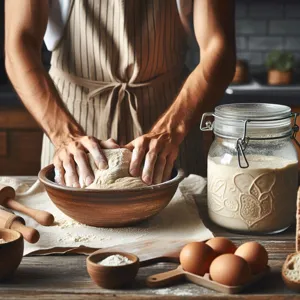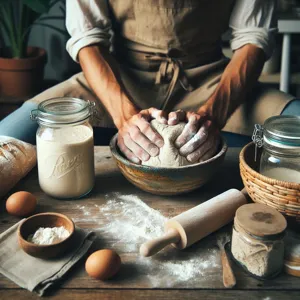There’s something undeniably magical about the aroma of freshly baked bread wafting through your home, especially when that bread is a beautifully crafted sourdough.
With its crusty exterior, chewy texture, and tangy flavor, sourdough has captured the hearts (and appetites) of bakers and food lovers alike. But the journey to mastering this artisanal bread can feel overwhelming for beginners and seasoned bakers alike. Fear not! In this comprehensive guide, we’ll demystify the sourdough-making process, breaking it down into easy-to-follow steps that will empower you to create your very own loaf from scratch. Whether you’re aiming to impress guests at your next gathering or simply want to enjoy the satisfaction of baking your own bread, our guide will provide you with valuable tips, techniques, and troubleshooting advice to ensure your sourdough journey is as rewarding as it is delicious. So, roll up your sleeves, grab your ingredients, and get ready to embark on a delightful culinary adventure!
1. Introduction to Sourdough: What Makes It Unique?

Sourdough bread is more than just a loaf; it’s a flavorful journey steeped in tradition and science. Unlike conventional bread that relies on commercial yeast for leavening, sourdough harnesses the power of wild yeast and lactic acid bacteria, naturally present in the environment, to rise. This unique fermentation process not only gives sourdough its distinctive tangy flavor but also contributes to a complex texture, with a crispy crust and a soft, airy crumb that is simply irresistible.
What truly sets sourdough apart is the culture of patience and care that comes with it. The initial step involves creating a sourdough starter, a living mixture of flour and water that captures wild yeasts from the air and your kitchen. This starter requires regular feeding and nurturing, transforming into a bubbly, vigorous culture that can be used to leaven your bread. The relationship you build with your starter is akin to that of a gardener tending to a plant; it thrives on attention and love, rewarding you with delicious results.
Additionally, the health benefits of sourdough cannot be overlooked. The fermentation process breaks down gluten and phytic acid, making the nutrients in the flour more accessible and easier to digest. Many people who struggle with gluten sensitivity have found sourdough to be a more forgiving option. Plus, the lactic acid produced during fermentation acts as a natural preservative, allowing your bread to stay fresh longer without the need for additives.
In this guide, we will delve deeper into the art of sourdough baking, exploring everything from creating your starter to mastering the perfect loaf. Whether you’re a seasoned baker or a curious beginner, you’ll find the steps straightforward and the rewards immensely satisfying. Get ready to embark on a delicious adventure that not only fills your home with the intoxicating aroma of freshly baked bread but also nourishes your creative spirit.
2. Understanding the Science Behind Sourdough
To truly master the art of sourdough, it’s essential to grasp the fascinating science that transforms simple ingredients into a loaf of bread with a unique tang and incredible texture. At its core, sourdough bread relies on a symbiotic relationship between wild yeast and beneficial bacteria, primarily Lactobacillus, which work together to ferment the dough.
When you mix flour and water and allow it to sit, you’re creating an environment where wild yeast from the air and the flour can settle in. This wild yeast is significantly different from the commercial yeast typically found in grocery stores. It’s slower acting and thrives on the natural sugars present in the flour, leading to a more complex flavor profile. Alongside the yeast, the lactic acid bacteria begin to proliferate, producing lactic and acetic acids that contribute to sourdough’s characteristic tanginess.
As the fermentation process unfolds, the dough becomes more elastic and develops a structure that traps the gas produced by the yeast, which is responsible for leavening the bread. This is where the gluten comes into play. The proteins in the flour hydrate and form gluten networks, giving the bread its chewy texture. During this process, enzymes break down starches into sugars, further feeding the yeast and enhancing the overall flavor.
Understanding this science isn’t just for the curious baker; it’s crucial for troubleshooting and perfecting your technique. A variety of factors—such as temperature, hydration, and the specific flour you use—can all influence the fermentation process. For instance, warmer temperatures accelerate fermentation, potentially leading to a more pronounced sour flavor, while cooler temperatures allow for a slower rise, creating a milder taste.
By appreciating the delicate balance of these elements, you’ll not only gain insights into why your sourdough behaves the way it does, but you’ll also learn how to manipulate these variables to achieve the perfect loaf. Whether you’re aiming for a subtle hint of sourness or a robust flavor, understanding the science behind sourdough will empower you to become a more confident and creative baker.
3. Essential Ingredients for Sourdough Bread

When it comes to crafting the perfect loaf of sourdough, understanding the essential ingredients is key. each component plays a vital role in developing the unique flavor, texture, and rise that sourdough is renowned for. Let’s break down these foundational ingredients that will transform simple elements into a true masterpiece.
**1. Flour:** The heart of your sourdough bread begins with high-quality flour. While all-purpose flour can work, opting for bread flour will yield a chewier texture thanks to its higher protein content, which aids gluten development. Many bakers also enjoy incorporating whole wheat or rye flour to enhance the flavor profile. These flours not only contribute to the bread’s depth but also add nutrients that feed the sourdough starter.
**2. Water:** Next to flour, water is crucial for bringing your dough to life. It hydrates the flour, dissolves the minerals and enzymes, and activates the gluten. The temperature of your water can also influence fermentation times. Generally, room temperature water (around 75°F to 80°F) is ideal for most home bakers, but feel free to experiment with warmer or cooler water to adjust your fermentation speed.
**3. Salt:** Often underestimated, salt is essential for flavor and control in the fermentation process. It strengthens the gluten structure and acts as a natural preservative, extending the shelf life of your bread. Sea salt or kosher salt is preferred over table salt due to its texture and purity. Just remember to add it to your dough after mixing in the flour and water to ensure even distribution.
**4. Sourdough Starter:** Finally, the star of the show—the sourdough starter. This living culture of flour and water is where the magic happens. It contains wild yeast and beneficial bacteria that ferment the dough, creating that signature tangy flavor and airy crumb. A well-fed starter will yield the best results, so be sure to maintain it properly and give it time to develop before use.
With these essential ingredients in hand, you’re ready to embark on your sourdough journey. Each element contributes to the symphony of flavors and textures that make sourdough bread so beloved. As you knead, shape, and bake, remember that the process is as important as the ingredients themselves—patience and practice will lead you to the artisanal loaf of your dreams. Happy baking!
4. Choosing the Right Flour: A Guide
When it comes to baking the perfect sourdough, the choice of flour is paramount. Flour is not just a mere ingredient; it is the foundation of your bread, influencing everything from texture and flavor to the rise and crust. Understanding the different types of flour available can help you make an informed decision that elevates your sourdough to artisanal levels.
**All-Purpose Flour**: This versatile flour is a staple in many kitchens and can serve as a solid base for sourdough. With a moderate protein content, it provides a good balance of strength and tenderness. While it may not yield the same depth of flavor as higher-protein options, it’s a great choice for beginners looking to dip their toes into sourdough baking.
**Bread Flour**: For those who crave a chewier crust and a more robust structure, bread flour is the way to go. With a higher protein content (typically around 12-14%), it promotes gluten development, resulting in a bread that rises beautifully and has a satisfying chew. This flour is particularly suited for sourdough, as it helps capture the gas released by the fermentation process, contributing to a lighter loaf.
**Whole Wheat Flour**: If you’re looking to add a nutty flavor and a bit more nutrition to your sourdough, whole wheat flour is an excellent option. While it can make your bread denser, the flavor it imparts is rich and satisfying. To achieve a balance, many bakers opt for a mix of whole wheat and bread flour, allowing the earthy notes of whole grain to shine through without compromising the loaf’s structure.
**Rye Flour**: For the adventurous baker, rye flour opens up a world of flavor possibilities. Known for its distinctive taste and dense crumb, rye flour is often used in combination with other flours to create a uniquely flavored sourdough. It has a lower gluten content, so use it in moderation to avoid overly dense bread. Rye not only adds complexity to your loaf but also enhances the fermentation process, thanks to its rich nutrient profile.
**Specialty Flours**: Don’t hesitate to experiment with specialty flours like spelt, einkorn, or even gluten-free mixes if you’re catering to specific dietary needs. Each brings its unique flavors and textures to the table, allowing for a creative twist on traditional sourdough.
When choosing your flour, consider the hydration level of your dough, as different flours absorb water differently. Higher protein flours typically require more hydration, so adjust your water ratios accordingly for optimal results.
Ultimately, the best flour for your sourdough is the one that aligns with your taste preferences and baking goals. With a little experimentation and an understanding of how each flour behaves, you’ll be well on your way to mastering the art of sourdough, creating loaves that not only rise beautifully but also tantalize the taste buds. Happy baking!
5. How to Create and Maintain a Sourdough Starter

Creating and maintaining a sourdough starter is the heart and soul of your sourdough baking journey. This living culture of flour and water is what brings your bread to life, providing that distinctive tangy flavor and delightful texture we all love. To embark on this fermentation adventure, you’ll need just two ingredients: flour and water.
**Step 1: The Initial Mix**
Start by combining equal parts of flour and water in a clean glass jar. A good ratio to begin with is 100 grams of flour to 100 grams of water. Stir until you achieve a thick, paste-like consistency, ensuring there are no dry pockets of flour. The type of flour you use can impact your starter—whole wheat flour tends to ferment faster due to its higher nutrient content, while all-purpose flour is also a reliable choice.
**Step 2: The Waiting Game**
Cover the jar loosely with a lid or a clean cloth to allow air to circulate while keeping out unwanted debris. Place it in a warm spot in your kitchen, ideally around 70-75°F (21-24°C). This is where the magic happens—wild yeast and bacteria from the environment will find their way into your mixture, starting the fermentation process.
**Step 3: Feeding Your Starter**
After 24 hours, you should see some bubbles forming, indicating that fermentation is underway. To feed your starter, discard half of the mixture (about 100 grams), and add another 100 grams of flour and 100 grams of water. Stir well, cover loosely, and return it to its warm spot. Repeat this feeding process daily for about 5 to 7 days. You’ll notice your starter becoming more active, bubbly, and aromatic with each feeding.
**Step 4: Recognizing Readiness**
Your starter is ready to use when it has doubled in size within 4 to 6 hours of feeding and produces a pleasant, slightly sour smell. To test its readiness, drop a small spoonful into a glass of water—if it floats, it’s time to bake!
**Step 5: Maintenance**
Once you have a robust starter, you can choose to keep it at room temperature (feeding daily) or refrigerate it (feeding weekly). If refrigerated, allow it to come to room temperature and feed it at least once before using it in your dough.
With patience and care, your sourdough starter will become a cherished kitchen companion, providing you with the foundation for delicious homemade bread. Embrace the journey of nurturing this living culture, and you’ll be rewarded with loaves that are as flavorful as they are fulfilling. Happy baking!
6. Step 1: Mixing the Dough
Mixing the dough is where the magic of sourdough begins. This initial step sets the foundation for your bread, influencing its texture, flavor, and overall character. Start by gathering your ingredients: high-quality bread flour, water, salt, and, of course, your active sourdough starter. The quality of your ingredients will significantly impact the final product, so choose a flour that has a good protein content for better gluten development.
In a large mixing bowl, combine the flour and salt first, ensuring they are evenly distributed. Next, add the bubbly sourdough starter, which should be at its peak activity, along with the water. Using a wooden spoon or your hands, gently mix the ingredients together until they form a shaggy mass. At this stage, don’t worry about achieving a perfectly smooth dough—it’s the mixing process that will help incorporate the ingredients and begin the gluten development.
As you mix, you’ll notice the dough becoming sticky and cohesive. This is a crucial moment; the warmth of your hands helps activate the starter, encouraging fermentation. Once the ingredients are combined, let the dough rest for about 30 minutes. This resting period allows the flour to fully hydrate and the gluten to relax, making it easier to knead later on.
After the rest, it’s time to knead. This can be done by hand or using a stand mixer fitted with a dough hook. Kneading helps develop the gluten structure, which is essential for trapping the gases produced by the fermentation process. Aim for a dough that is smooth, elastic, and slightly tacky to the touch, but not overly sticky.
As you embark on this step, take a moment to appreciate the transformation happening in front of you. The simple combination of flour, water, and starter is starting to come alive, setting the stage for the delicious sourdough bread that awaits. The journey of sourdough is not just about following a recipe; it’s about engaging with the ingredients and nurturing them through each phase, and mixing the dough is a beautiful beginning to this artisanal adventure.
7. Step 2: Autolyse: The Key to Flavor and Texture

Autolyse is a vital step in the sourdough bread-making process, and it’s where the magic truly begins. After measuring your flour and water, allow them to mingle in a bowl, creating a shaggy, unformed mass. The term “autolyse,” derived from the Greek word meaning “to break down,” refers to this crucial resting period where time works in your favor.
During the autolyse, which typically lasts anywhere from 20 minutes to an hour, the flour begins to absorb the water. This hydration not only helps to activate the enzymes present in the flour but also initiates the gluten development process. As the flour absorbs water, it transforms from a dry, powdery substance into a cohesive, elastic dough, setting the foundation for the bread’s structure. This is your opportunity to cultivate the dough’s flavor and texture, as the enzymes break down starches into sugars and proteins into amino acids, enriching the final taste.
As you watch the dough rest, you might notice that it becomes smoother and more pliable, almost like a living entity. The aroma that wafts up during this time is a delightful precursor to the bread that awaits. The autolyse also enhances the dough’s extensibility, making it easier to shape later on.
Don’t rush this step; the longer the autolyse, the deeper the flavors will develop. This patience pays off in the end, as you’ll be rewarded with a loaf that boasts a complex flavor profile and a beautifully chewy texture. So, take a moment to appreciate the transformation happening in your bowl—this is where your journey towards baking exceptional sourdough truly begins. Once your autolyse is complete, you’ll be ready to move on to the next exciting phase of your sourdough adventure: mixing in your starter and salt to create a dough that’s ready to rise and shine.
8. Step 3: Bulk Fermentation: Developing Flavor
### Step 3: Bulk Fermentation: Developing Flavor
As you embark on the journey of sourdough baking, bulk fermentation is where the magic truly begins. This crucial step not only allows the dough to rise but also plays a vital role in developing the complex flavors that sourdough is renowned for.
Once you’ve mixed your ingredients—your flour, water, starter, and salt—it’s time to let the dough rest and come alive. Pour your mixture into a large, clean bowl, and cover it with a damp cloth or plastic wrap to keep it moist. The bulk fermentation phase typically lasts anywhere from 4 to 6 hours, depending on the temperature of your kitchen and the strength of your starter.
During this time, you’ll notice a beautiful metamorphosis taking place. The dough will gradually increase in volume, becoming airy and light. This is due to the natural fermentation process, where wild yeast and beneficial bacteria from your sourdough starter feast on the sugars in the flour, producing carbon dioxide and organic acids. The result? A dough that not only rises but also develops a nuanced flavor profile that’s tangy and rich.
To enhance this process, consider performing a series of stretch and folds every 30 minutes during the first couple of hours of bulk fermentation. Gently pull one edge of the dough up and fold it over to the center, rotating the bowl as you go. This technique strengthens the gluten structure, helps incorporate air, and further encourages flavor development.
As you monitor your dough, keep an eye on its texture and appearance. A well-fermented dough will feel smooth and elastic, with small bubbles forming on the surface, indicating that fermentation is in full swing. When the dough has roughly doubled in size and retains a slight domed shape, it’s time to move on to the next step.
Bulk fermentation is not just about waiting; it’s about observing and understanding the transformation your dough is undergoing. Embrace the process, and savor the anticipation of the delicious sourdough that awaits you!
9. Step 4: Shaping the Dough: Techniques for Success
Shaping your dough is a crucial step in the sourdough baking process, one that can significantly affect the final texture and appearance of your bread. At this stage, your dough has risen beautifully, and it’s time to turn it into a shape that will not only hold its form but also create the ideal crust and crumb structure for the perfect loaf.
Begin by lightly flouring your work surface to prevent sticking. Gently turn the dough out from its bowl, being careful not to deflate it too much. You want to maintain the air pockets that have formed during fermentation; these will contribute to your bread’s airy texture.
Now comes the folding technique. With floured hands, stretch the edges of the dough towards the center, folding it over itself. This process helps to build tension in the dough, which is essential for achieving a good rise during baking. Once you’ve folded all sides into the center, flip the dough over so the smooth side is facing up.
Next, it’s time to shape. For a round loaf, use your hands to gently cup the dough and pull it towards you, dragging it slightly across the counter. This motion helps to create surface tension. For a batard or oval shape, you’ll want to flatten the dough slightly, then roll it towards you while tucking in the sides. Each shape has its own unique character, so choose one that appeals to you or complements your baking goals.
Practice makes perfect here; don’t be discouraged if your first few attempts aren’t picture-perfect. As you gain confidence, you’ll develop a knack for recognizing when your dough is ready to be shaped and how much tension to create.
Once you’ve shaped your dough, it’s time to let it rest in a proofing basket or on a floured surface, covered with a damp cloth to prevent drying. This final fermentation period is your opportunity to let the dough relax and rise once more, resulting in a beautifully shaped loaf that will impress both you and anyone lucky enough to taste your creation.
Remember, the shaping process is not just about aesthetics; it’s about creating the conditions for a successful bake. With a little practice and patience, you’ll master this essential technique and elevate your sourdough baking to new heights.
10. Step 5: Proofing: The Art of Timing
Proofing is where the magic truly happens in the sourdough process. This step is crucial for developing the flavor, texture, and overall character of your bread. After shaping your dough, it’s time to let it rest, allowing the yeast to work its wonders. The timing of this phase can greatly influence the outcome of your loaf, so understanding the art of timing is essential.
As you place your shaped dough into a proofing basket or bowl, cover it gently with a damp cloth or plastic wrap to maintain humidity and prevent a crust from forming. The ideal proofing environment is warm and draft-free, with a temperature range of about 75°F to 85°F. This cozy setting encourages the yeast to ferment and produce carbon dioxide, causing the dough to rise and develop those delightful bubbles that give sourdough its signature texture.
The duration of proofing can vary based on several factors, including the strength of your starter, the ambient temperature, and the hydration level of your dough. Typically, a bulk fermentation period lasts anywhere from 4 to 12 hours, but this can extend to 24 hours in cooler conditions. During this time, you should keep a close eye on your dough; look for it to double in size and become airy and puffy.
To help you gauge when your dough is ready, you might want to employ the “poke test.” Gently press your finger into the surface of the dough; if the indentation springs back slowly, it’s ready for the next stage. If it springs back quickly, give it a bit more time. Conversely, if the dough doesn’t spring back at all, it may have over-proofed, leading to potential issues in the baking stage.
Remember, proofing is as much an art as it is a science. It requires practice and a bit of intuition to master, so don’t be discouraged by early attempts. Embrace the process, and soon you’ll find the perfect balance of timing that results in a beautifully risen, flavorful sourdough loaf that will have your kitchen filled with the irresistible aroma of freshly baked bread.
11. Step 6: Scoring and Baking Your Sourdough
As you approach the final stages of your sourdough journey, it’s time to unleash your creativity and ensure a perfect bake with Step 6: Scoring and Baking Your Sourdough. This step is not only practical but also an opportunity to showcase your artistic flair.
**Scoring Your Dough**
Before sliding your beautiful loaf into the oven, scoring is a critical technique that allows the bread to expand properly during baking. Skipping this step might result in a loaf that bursts unpredictably, leading to an uneven crumb structure. To score your dough, use a sharp blade or a lame—an essential tool for any serious baker. Hold the blade at a slight angle and make swift, confident cuts on the surface of the dough. You can opt for simple slashes or create intricate patterns; the choice is yours! This not only enhances the visual appeal but also adds an artisanal touch to your sourdough.
**Baking Your Sourdough**
Now comes the moment you’ve been waiting for: baking! Preheat your oven to a high temperature, usually around 450°F (232°C). If you have a Dutch oven, place it inside the oven to preheat as well; this will help create a steamy environment crucial for achieving that coveted crispy crust. Once the oven is hot, carefully transfer your scored dough into the pot (you can use parchment paper for easier handling) and cover with the lid. This initial steam will help the bread rise beautifully.
After about 30 minutes, remove the lid to let the crust develop a rich, golden-brown color. Monitor the loaf closely as it bakes for an additional 15 to 20 minutes, until you achieve that enticing crust you’ve been dreaming about. The aroma wafting through your kitchen will be nothing short of heavenly.
As the baking concludes, tap the bottom of the loaf; a hollow sound signifies that your sourdough is done. Remove it from the oven and let it cool on a wire rack. Patience is key here—resist the urge to slice into it immediately, as letting it rest helps to set the crumb and flavor.
In this step, you’ll not only see the fruits of your labor but also experience the joy of transforming simple ingredients into a masterpiece. Scoring and baking your sourdough is where the magic truly happens, leading to a loaf that is both stunning to behold and delicious to taste. Enjoy the fruits of your hard work, and prepare to share your creation with friends and family!
12. Troubleshooting Common Sourdough Problems
Baking sourdough bread is as much an art as it is a science, and like any creative endeavor, it can come with its fair share of challenges. If you find yourself facing some common sourdough problems, don’t feel discouraged—every baker encounters hurdles along the way. Understanding how to troubleshoot these issues can help you refine your technique and achieve that perfect loaf.
One of the most frequent problems is a loaf that doesn’t rise properly. If your sourdough is dense and flat, it might be a sign that your starter isn’t active enough. Ensure your starter is bubbly and has doubled in size after feeding before you mix it into your dough. Additionally, consider the temperature of your environment; sourdough thrives in warmth, so a chilly kitchen might require longer fermentation times.
Another common issue is a crust that is either too hard or too soft. If you’re facing a crust that could double as armor, it may be due to baking at too high a temperature or not using enough steam in the oven. A hot oven and an initial burst of steam can create that desirable crust. Conversely, if your crust is soft and chewy, try increasing the baking time or temperature, as well as ensuring you’re using a preheated baking vessel.
If your bread has a gummy texture, it might not have been baked long enough, or the dough may have been too wet. Experiment with adjusting your hydration levels and make sure to monitor the internal temperature with an instant-read thermometer—aim for about 200 to 210 degrees Fahrenheit for a fully baked loaf.
Lastly, if you notice a weird smell or off flavors in your bread, it’s crucial to examine your ingredients and processes. Stale flour or an improperly maintained starter can introduce unwanted flavors. Regularly refresh your starter and store your flour in a cool, dry place to maintain freshness.
By identifying these common pitfalls and knowing how to address them, you can cultivate your sourdough skills and create loaves that are not only beautiful but also bursting with flavor. Remember, every loaf is a learning experience, so embrace the journey of mastering the art of sourdough!
13. Tips for Storing and Freezing Sourdough Bread
Once you’ve successfully baked your own delicious sourdough bread, it’s essential to know how to store and preserve it so you can enjoy its crusty goodness long after it’s come out of the oven. Proper storage will help maintain the bread’s texture and flavor, ensuring every slice remains as delightful as the first.
### Storing Sourdough Bread
The key to maintaining the freshness of your sourdough lies in how you store it. Ideally, you want to keep your bread at room temperature to allow its crust to stay crisp while preventing it from going stale too quickly. Wrap your loaf in a clean kitchen towel or place it in a paper bag; this helps absorb excess moisture while still allowing the bread to breathe. Avoid plastic wrap or bags, as they can trap moisture, leading to a soft crust and potential mold growth.
If you’re planning to consume your bread within a few days, this method will suffice. However, if you have a larger loaf or simply want to extend its shelf life, consider using a bread box, which provides a dark and dry environment that preserves the bread effectively.
### Freezing Sourdough Bread
For longer storage, freezing is a fantastic option. Start by allowing your bread to cool completely to prevent condensation from forming when wrapped. Slice the loaf into portions, which makes it easier to grab just what you need later without having to defrost the entire loaf. Wrap each slice tightly in plastic wrap or aluminum foil, and then place the wrapped slices inside a freezer-safe bag or container to protect against freezer burn.
When you’re ready to enjoy your sourdough again, simply remove the number of slices you need and let them thaw at room temperature. For an extra touch, pop the slices in the toaster or under the broiler for a few minutes to revive that lovely crispy crust. By following these tips for storing and freezing your sourdough bread, you can savor its artisanal flavor and texture for weeks to come, making each meal a delightful experience.
14. Creative Variations: Adding Flavor and Texture
Once you’ve mastered the basic sourdough recipe, the world of flavor and texture awaits you. This is where your creativity can truly shine as you experiment with various ingredients to elevate your bread from simple staple to a delightful culinary experience.
Begin by considering herbs and spices—these can be added directly to your dough during the mixing stage. Fresh rosemary, thyme, or basil can impart a fragrant aroma and a savory twist. For a touch of warmth, try incorporating ground spices like cinnamon or nutmeg, which work beautifully in sweeter loaves.
Next, think about incorporating grains and seeds. Adding whole grains such as oats, rye, or barley can enhance the nutritional profile of your bread while introducing a hearty texture. Seeds like sunflower, sesame, or flax not only contribute a delightful crunch but also a nutty flavor that complements the sourdough’s tanginess. A touch of olive oil can enhance moisture and richness, making your loaves even more irresistible.
Fruits and nuts present another exciting avenue for experimentation. Dried fruits, such as cranberries, figs, or apricots, add sweetness and a burst of flavor, while nuts like walnuts, almonds, or pecans create a satisfying contrast with their crunch. For a more indulgent treat, consider swirling in chocolate chips or a rich caramel mixture just before shaping your dough.
Don’t forget about the impact of different types of flour! While traditional bread flour provides a solid foundation, experimenting with alternative flours like spelt, einkorn, or even gluten-free options can produce distinct flavors and textures, making each loaf a unique creation.
As you explore these creative variations, keep in mind that balance is key. Aim for complementary flavors that enhance rather than overpower the inherent sourdough profile. Document your experiments, noting what works and what doesn’t, and soon you’ll have a repertoire of signature sourdough recipes that not only satisfy your taste buds but also impress those lucky enough to share in your baking journey. Happy baking!
15. Conclusion: The Joy of Baking Your Own Sourdough Bread
As we reach the conclusion of our sourdough journey, it’s essential to reflect on the profound joy that comes from baking your own bread. There’s something magical about transforming simple ingredients—flour, water, salt, and a little patience—into a warm, crusty loaf that fills your home with an irresistible aroma. The process of nurturing your starter, watching it bubble and rise, is akin to tending to a living creature, fostering a connection that deepens with each bake.
Baking sourdough is not just about the final product; it’s about the experience. Each step, from the initial mixing to the rhythmic kneading and the anxious wait for the dough to rise, is an opportunity for mindfulness. It encourages you to slow down and appreciate the art of creation, turning a seemingly mundane task into a fulfilling ritual. The sense of accomplishment when you finally slice into a loaf you’ve crafted yourself is unparalleled. The crust crackles under your knife, revealing a soft, airy interior that you can’t wait to slather with butter or enjoy alongside your favorite spread.
Moreover, sourdough baking fosters a spirit of community. Sharing your homemade loaves with friends, family, or neighbors not only spreads joy but also creates bonds over the shared experience of bread-making. You may find yourself swapping tips and techniques, discovering new flavors, and even passing on your starter to a loved one, continuing the cycle of creativity and connection.
In conclusion, mastering the art of sourdough baking is more than just a culinary skill; it’s a journey filled with discovery, patience, and delight. Whether you’re a seasoned baker or a curious beginner, embracing the process allows you to savor not just the bread, but the entire experience. So, roll up your sleeves, grab your ingredients, and immerse yourself in the delightful world of sourdough. Happy baking!




